Module 12 − Modulation Principles
Pages i,
1−1,
1−11,
1−21,
1−31,
1−41,
1−51,
1−61,
1−71,
2−1,
2−11,
2−21,
2−31,
2−41,
2−51,
2−61,
3−1,
3−11,
3−21,
3−31, AI−1, Index, Assignment 1, 2
modulator varies the
voltage of the cathode to produce the modulation envelope. Since the cathode is in series with the grid and plate
circuits, you should be able see that changing the cathode voltage will effectively change the voltage of the
other tube elements. By properly controlling the voltages on the tube, you can cause the cathode modulator to
operate in a form of plate modulation with high efficiency. Usually, the cathode modulator is designed to perform
about midway between plate and grid modulator levels, using the advantages of each type. When operated between the
two levels, the modulator provides a more linear output with moderate efficiency and a modest audio power
requirement.
In figure 1-50, the RF carrier is applied to the grid of V1 and the modulating signal is applied in series
with the cathode through T1. Since the modulating signal is effectively in series with the grid and plate voltage,
the level of modulating voltage required will be determined by the relationships of the three voltages. The
modulation takes place in the plate circuit with the plate tank developing the modulation envelope, just as it did
in the plate modulator. 
Figure 1-50. - Cathode modulator. Emitter-Injection Modulator This is the transistor equivalent of the cathode
modulator. The Emitter-INJECTION Modulator has the same characteristics as the base-injection modulator discussed
earlier. It is an 1-61
extremely low-level modulator that is useful in portable equipment. In emitter-injection modulation,
the gain of the RF amplifier is varied by the changing voltage on the emitter. The changing voltage is caused by
the injection of the modulating signal into the emitter circuitry of Q1, as shown in figure 1-51. Here the
modulating voltage adds to or subtracts from transistor biasing. The change in bias causes a change in collector
current and results in a heterodyning action. The modulation envelope is developed across the collector-tank
circuit.
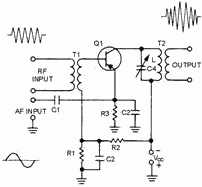
Figure 1-51. - Emitter-injection modulator. Q-44. When is a control-grid modulator used? Q-45. What type of modulator is the cathode modulator
(low- or high-level)? Q-46. What causes the change in collector current in an emitter-injection modulator?
You have studied six methods of amplitude modulation. These are not the only methods available, but
they are the most common. All methods of AM modulation use the same theory of heterodyning across a nonlinear
device. AM modulation is one of the easiest and least expensive types of modulation to achieve. The primary
disadvantages of AM modulation are susceptibility to noise interference and the inefficiency of the transmitter.
Power is wasted in the transmission of the carrier frequency because it contains no AM intelligence. In the next
chapter, you will study other forms of modulation that have been developed to overcome these disadvantages.
Summary
Now that you have completed this chapter, a short review of what you have learned is in order.
The following summary will refresh your memory of amplitude modulation, its basic principles, and typical
circuitry used to generate this modulation. The SINE WAVE is the basis for all complex
waveforms and is generated by moving a coil through a magnetic field. 1-62

Amplitude (instantaneous voltage) of a coil is found by the formula: 

Phase or Phase ANGLE is the angle that exists between the starting
position of a vector generating the sine wave and its position at a given instant. Frequency
is the rate at which the vector rotates. HETERODYNING is the process of mixing two
different frequencies across a nonlinear impedance to give the ORIGINAL frequencies, a SUM frequency, and a
Difference frequency.
1-63
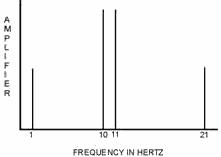
CONTINUOUS-WAVE MODULATION is the basic form of RF communications. It is essentially
on-off keying of an RF carrier.

Hand-OPERATED and MACHINE KEYING are two types of CW keying.
PLATE,
CATHODE, and BlockED-GRID KEYING are circuits commonly used in hand-operated and
machine keying. KEYING RELAYS are used for safety and to handle the current requirements
in high-power transmitters. 1-64

KEY-CLICK FILTERS are used to prevent interference in CW transmitters.
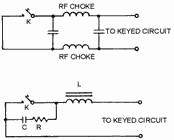
Although it is a relatively slow transmission method, CW Communications is highly reliable under severe
noise conditions for long-range operation. Single-Stage CW Transmitters can be made by
coupling the output of an oscillator to an antenna. 1-65
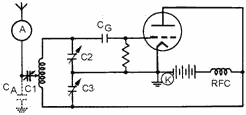
MULTIsTAGE CW Transmitters are used to improve frequency stability and increase output
power. 
A MICROPHONE is an energy converter that changes sound energy into electrical energy.
 A CARBON MICROPHONE uses carbon granules and an external battery supply to generate AF
voltages from sound waves. 1-66
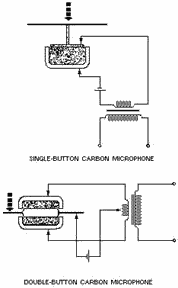
A Crystal MICROPHONE uses the piezoelectric effect to generate an output voltage. 
A DYNAMIC MICROPHONE uses a coil of fine wire mounted on the back of a diaphragm located
in the magnetic field of a permanent magnet. 1-67
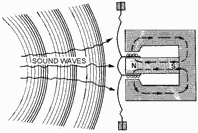
A Magnetic MICROPHONE uses a moving armature in a magnetic field to generate an output.

The Frequency SPECTRUM of a modulated wave can be conveniently illustrated in graph form
as frequency versus amplitude. 1-68

The MODULATION ENVELOPE is the waveform observed when the CARRIER, Upper SIDEBand, and
LowER SIDEBand are combined in a single impedance and observed as time versus amplitude. 
The Bandwidth of an RF signal is the amount of space in the frequency spectrum used by
the signal. PERCENT of MODULATION is a measure of the relative magnitudes of the RF
carrier and the AF modulating signal. 1-69
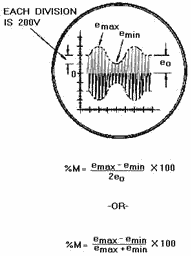
High-LEVEL MODULATION is modulation produced in the plate circuit of the last radio stage
of the system. Low-LEVEL MODULATION is modulation produced in an earlier stage than
the final power amplifier. The PLATE Modulator is a high-level modulator. The
modulator tube must be capable of varying the plate-supply voltage of the final power amplifier. It must vary the
plate voltage so that the plate current pulses will vary between 0 and nearly twice their unmodulated value to
achieve 100-percent modulation. 1-70
| - |
Matter, Energy,
and Direct Current |
| - |
Alternating Current and Transformers |
| - |
Circuit Protection, Control, and Measurement |
| - |
Electrical Conductors, Wiring Techniques,
and Schematic Reading |
| - |
Generators and Motors |
| - |
Electronic Emission, Tubes, and Power Supplies |
| - |
Solid-State Devices and Power Supplies |
| - |
Amplifiers |
| - |
Wave-Generation and Wave-Shaping Circuits |
| - |
Wave Propagation, Transmission Lines, and
Antennas |
| - |
Microwave Principles |
| - |
Modulation Principles |
| - |
Introduction to Number Systems and Logic Circuits |
| - |
- Introduction to Microelectronics |
| - |
Principles of Synchros, Servos, and Gyros |
| - |
Introduction to Test Equipment |
| - |
Radio-Frequency Communications Principles |
| - |
Radar Principles |
| - |
The Technician's Handbook, Master Glossary |
| - |
Test Methods and Practices |
| - |
Introduction to Digital Computers |
| - |
Magnetic Recording |
| - |
Introduction to Fiber Optics |
| Note: Navy Electricity and Electronics Training
Series (NEETS) content is U.S. Navy property in the public domain. |
|



























